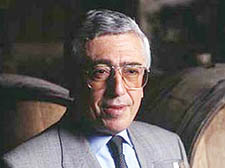|
|
 |
| |

Lebanese producer Serge Hochar, of Chateau Musar, continues to make wine following
traditional methods |
Great traditions won’t be shelved by producers
Wine-making may be changing, but many brands continue to follow ‘traditional’ methods, and are achieving some surprising results
NONE of these Lebanese, French, Georgian or Italian wines (see panel) can be described as ‘New World’, since they were chosen for their traditional qualities. But what does ‘traditional’ mean?
We’ve learned from historians Eric Hobsbawm and Terence Ranger that traditions often turn out to be comparatively new inventions, often referring to some spurious ‘golden age’. But, in this instance, tradition is attached to a range of different meanings.
None of these wines can be described as fruity or accessible. Nor are their merits immediately apparent. But all repay careful attention.
The Cuvée Rouge 2004 from Château Musar blends cinsault, carignan and syrah with cabernet sauvignon, rather than the mix of grapes we typically associate with traditional clarets.
Nonetheless, this wine was made without refrigeration in concrete vessels and hasn’t been filtered. But while the wine-making process is traditional, the grape varieties are not.
In contrast, the Château Pleyssac-Tayac comprises just this, with 75 per cent merlot, 20 per cent cabernet franc and 5 per cent cabernet sauvignon matured in barrels for 12 to 16 months. The wine-making itself is likely to conform to modern practices with stainless-steel fermentation vessels and careful filtration.
The Italian wine, probably not available outside its own region around Trieste in north eastern Italy, has been included because it is typical of what many of us bring back from holiday.
Judged by its relative softness, it was probably produced by modern methods. Yet the cabernet sauvignon grape gives it a good structure and it improved as tasting progressed. Not surprisingly, it’s popular with local people.
Finally, the Georgian wine is made from a grape variety (saperavi) native to its country of origin, but modified by a New World winemaker to meet western tastes.
Therefore we have: a wine produced without refrigeration with types of grape likely to be found in the New World; a second using traditional grape varieties but modern production methods; a third in which ‘tradition’ is attached to location rather than grape varieties and production techniques, and a fourth using a local grape doctored by modern methods for its intended market.
The surprising thing is the similarity between the four wines. They’re all comparatively light, both in terms of alcoholic content and taste – subdued, with a firm but complex structure. None of them would attract much attention in international wine competitions, nor should any of them be drunk without food.
While none is available in the major supermarkets, they are all at least as good as anything you’ll find in a supermarket at a similar price.
Four people tasted the wines. One particularly liked the Lebanese; the other three liked the other wines best but were unable to choose between them – an unexpected result, but this doesn’t mean that the wines were dull. Significantly, when a bottle of Kumala, the popular South African blend of cabernet and merlot, was introduced surreptitiously into the tasting there was a strong negative reaction!
All four wines are formulated to complement certain types of food. What is most attractive about them is their balance, relative complexity and lack of pretension.
They appear to have benefited from aging. Each in some way denies tradition, but they all show traditional qualities common until the late 1970s.
They are, in themselves, good wines, but also serve as a measure of how far wine has changed during the past 30 years. |
 |
|
| |

|
|
 |
|









